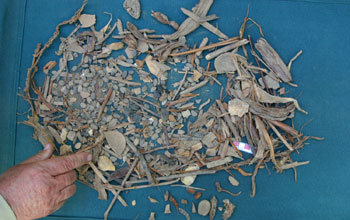Multimedia Gallery
Work at Caballete (Image 2)
A botanic bundle excavated from a test pit at Caballete in the Fortaleza river valley in north-central Peru. The botanic material is composed of gourd seeds, pacae, aji, cane fibers and twigs. Fifty-four bundles of willow branches were found at the bottom of the test pit, and archaeologists believe they may have been pre-construction offerings.
This work is part of Proyecto Arqueológico Norte Chico (PANC), a 15-year investigation being conducted by Chicago's Field Museum into the emergence of complex societies in north-central Peru during the third millennium B.C. Research in 2002 and 2003 was supported by a grant from the National Science Foundation's Division of Behavioral and Cognitive Sciences (grant BCS 02-11014). (Date of Image: 2003-2004) [One of 12 related images. See Next Image.]
More about this Image
PANC research is focused in the Norte Chico region, which includes four river valleys--Huaura, Supe, Pativilca and Fortaleza--ranging from 150 to 200 kilometers north of Lima. This region was home to a large number of ceremonial and residential centers dating to the "Late Archaic" period(1800 to 3000 B.C.).
In 2002 and 2003, PANC conducted limited excavations in the Pativilca and Fortaleza river valleys. The 2002 work focused on seven major centers and two cemeteries (known as CR and CP) in the Pativilca river valley. The 2003 work focused on six major centers in the Fortaleza river valley. The Pativilca sites consisted of Carreteria, Huayto, Potao, Pampa San Jose, Punta y Suela, Upaca and Vinto Alto. In the Fortaleza river valley, excavations were conducted at Porvenir, Caballete, Cerro Blanco site 1, Cerro Blanco site 2, Huaricanga and Shaura. At all of these sites, the excavation strategies were similar. Since the mound structures had been subjected to disturbance, either from looters or modern construction, an effort was made to salvage information from the disturbed areas. The sides of looters pits or bulldozer trenches were straightened, cleaned and drawn. Samples of organic materials were taken from different occupation layers when possible, for radiocarbon dating. At most of the sites, additional excavation was conducted to retrieve in-situ tool assemblages, as well as floral and faunal remains.
This research was supported by a grant from the National Science Foundation's Division of Behavioral and Cognitive Sciences (grant BCS 02-11014). Further information about this research can be found at http://www.fieldmuseum.org/panc/proj_desc.htm.
Credit: ©2003 Field Museum
Images and other media in the National Science Foundation Multimedia Gallery are available for use in print and electronic material by NSF employees, members of the media, university staff, teachers and the general public. All media in the gallery are intended for personal, educational and nonprofit/non-commercial use only.
Images credited to the National Science Foundation, a federal agency, are in the public domain. The images were created by employees of the United States Government as part of their official duties or prepared by contractors as "works for hire" for NSF. You may freely use NSF-credited images and, at your discretion, credit NSF with a "Courtesy: National Science Foundation" notation.
Additional information about general usage can be found in Conditions.
Also Available:
Download the high-resolution JPG version of the image. (1.4 MB)
Use your mouse to right-click (Mac users may need to Ctrl-click) the link above and choose the option that will save the file or target to your computer.



